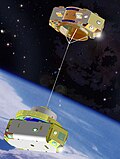Gravity-gradient stabilization or tidal stabilization is a passive method of stabilizing artificial satellites or space tethers in a fixed orientation...
9 KB (988 words) - 13:19, 17 July 2025
practical applications. Gravity-gradient stabilization – Method for the stabilization and the orientation of various spacecraft Gravity map Robert L. Forward#Forward...
14 KB (1,688 words) - 21:36, 1 July 2025
are advantages and disadvantages to both spin stabilization and three-axis stabilization. Spin-stabilized craft provide a continuous sweeping motion that...
31 KB (4,092 words) - 04:43, 12 July 2025
successfully performed rendezvous during Project Gemini, the gravity-gradient stabilization test on Gemini 11 was unsuccessful. NASA also had concerns about...
124 KB (12,671 words) - 17:42, 9 August 2025
was to investigate the possibilities of a gravity gradient stabilization system (the method of stabilizing artificial satellites). The satellite has a...
7 KB (512 words) - 01:02, 22 July 2025
strategies focused on passive methods like magnetic damping and gravity-gradient stabilization. Modern satellites typically employ an active detumbling control...
20 KB (2,033 words) - 22:15, 7 August 2025
tore off a 2.8-2.9 metre (9.2-9.5 foot) portion of Cerise's gravity-gradient stabilization boom, which left the satellite severely damaged and tumbling...
6 KB (427 words) - 13:55, 28 May 2025
109 kg satellite was used to test the feasibility of using gravity-gradient stabilization in Transit navigational satellites. It provided information...
4 KB (273 words) - 17:06, 10 November 2024
(Department of Defense Gravity Experiment) was a satellite whose primary purpose was to conduct experiments in gravity-gradient stabilization at near-geosynchronous...
4 KB (232 words) - 11:22, 17 August 2024
April 2021. ATS-4 was to investigate the possibilities of a gravity gradient stabilization system. A Centaur upper stage failure stranded ATS-4 in a much...
6 KB (406 words) - 03:16, 17 September 2024
GGSE-1 (redirect from Gravity Gradient Stabilization Experiment)
The Gravity Gradient Stabilization Experiment (GGSE-1) was a technology satellite launched simultaneously with four other satellites (including SOLRAD...
5 KB (515 words) - 00:12, 16 April 2025
displaying short descriptions of redirect targets Gravity-gradient stabilization – Method for the stabilization and the orientation of various spacecraft Kozai...
47 KB (5,088 words) - 07:37, 11 June 2025
hand-holds to the Agena and installed the cable needed for the gravity-gradient stabilization experiment. He performed several tasks, including installing...
96 KB (9,957 words) - 09:18, 10 August 2025
the Progress pointed toward Earth. This placed the station in gravity-gradient stabilization. Lebedev remarked in his diary that the attitude control jets...
8 KB (652 words) - 00:51, 25 February 2025
The Gravity Gradient Test Satellite was launched by the US Air Force from Cape Canaveral LC41 aboard a Titan IIIC rocket on June 16, 1966, at 14:00:01...
4 KB (297 words) - 15:04, 28 May 2025
GGSE may refer to: Gravity-gradient stabilization, a method of stabilizing artificial satellites GGSE-1, a technology satellite launched by the US military...
380 bytes (89 words) - 11:25, 30 January 2020
purposes of the TSS-1 mission were to verify the tether concept of gravity gradient stabilization, and to provide a research facility for investigating space...
44 KB (5,641 words) - 23:43, 17 April 2025
The Gravity Gradient Stabilization Experiment (GGSE-4) was a technology satellite launched in 1967. This was ostensibly the fourth in a series that developed...
4 KB (457 words) - 19:20, 14 October 2024
stability in uncontrolled mode. This technique is now known as gravity-gradient stabilization. Using a similar tether and a few thruster bursts to rotate...
18 KB (1,918 words) - 15:53, 18 July 2024
station's Kaskad orientation system. The station operated in gravity-gradient stabilized mode between 24 and 26 June to avoid attitude control system...
15 KB (1,620 words) - 11:41, 23 April 2025
first non-destructive latching of two satellites. Gravity-gradient stabilization, a passive stabilization technique Niccolò Bellini (2014-09-10). Magnetic...
10 KB (1,206 words) - 03:38, 30 July 2025
Momentum exchange tether (section Tidal stabilization)
or angular momentum occurs. Gravity-gradient stabilization, also called "gravity stabilization" and "tidal stabilization", is a simple and reliable method...
22 KB (2,741 words) - 18:37, 16 February 2025
expected to pass as closely as 12 meters from the U.S. Air Force's Gravity Gradient Stabilization Experiment (GGSE-4) of 1967, another un-deorbited satellite...
19 KB (1,579 words) - 19:28, 7 June 2025
away from earth. Attitude control of LDEF was achieved with gravity-gradient stabilization and inertial distribution to maintain three-axis stability in...
17 KB (1,633 words) - 23:05, 30 July 2025
into a Mars orbit, providing a low-gravity gradient to the spacecraft during the entire journey. This form of gravity is not without challenges, however...
38 KB (4,596 words) - 16:15, 10 July 2025
USU GAS team. The AeroBoom was designed as an alternative to Gravity-gradient stabilization for spacecraft using passive attitude control in Low Earth orbit...
18 KB (1,597 words) - 21:59, 17 July 2025
navigation. However, this satellite was the first to achieve gravity-gradient stabilization, and its other subsystems performed well. Surveyors used Transit...
32 KB (3,712 words) - 08:02, 31 May 2025
the satellite was covered by solar panels, and it utilized gravity-gradient stabilization for control. The following 12 experiments were conducted: Radio...
5 KB (397 words) - 01:02, 22 July 2025
primary and secondary reflectors. The entire structure may be gravity gradient stabilized. Alternative designs include: Swarms of smaller satellites: Some...
112 KB (12,821 words) - 11:26, 5 July 2025
configuration of the POPPY constellation. Satellites used 2- or 3-axis gravity gradient stabilization. POPPY Block I (NRL Composite 2) POPPY Block II (NRL Composite...
11 KB (836 words) - 14:07, 4 June 2025























